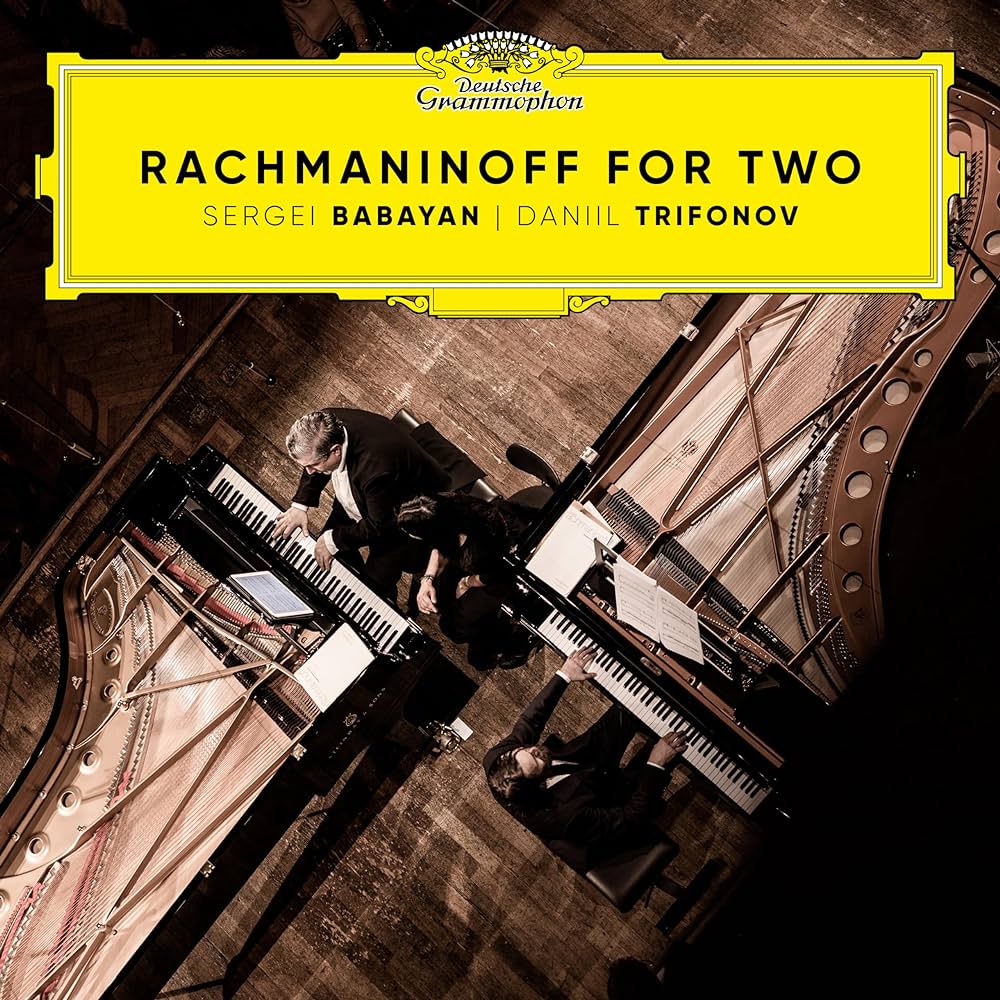RACHMANINOV Piano Duos (Babayan; Trifonov)
View record and artist detailsRecord and Artist Details
Composer or Director: Daniil Trifonov
Genre:
Instrumental
Label: Deutsche Grammophon
Magazine Review Date: 05/2024
Media Format: CD or Download
Media Runtime: 86
Mastering:
DDD
Catalogue Number: 486 4805

Tracks:
| Composition | Artist Credit |
|---|---|
| Suite No. 1, 'Fantaisie-tableaux' |
Sergey Rachmaninov, Composer
Daniil Trifonov, Composer Serge Babayan, Piano |
| Suite No. 2 |
Sergey Rachmaninov, Composer
Daniil Trifonov, Composer Serge Babayan, Piano |
| Symphonic Dances (cham) |
Sergey Rachmaninov, Composer
Daniil Trifonov, Composer Serge Babayan, Piano |
| Symphony No. 2, Movement: Adagio |
Sergey Rachmaninov, Composer
Daniil Trifonov, Composer Serge Babayan, Piano |
Author: Marina Frolova-Walker
This album of Rachmaninov’s two-piano music offers a winning mix of limitless pianism, deep knowledge and visionary boldness. Add to this a perfect understanding between Trifonov and Babayan, who was once Trifonov’s teacher and is now his friend and musical collaborator. What we have, then, is a recipe for something extraordinary.
Traditionally, there are three ways of playing Rachmaninov. There’s the romantically lush, heart-on-sleeve approach. There’s the lower-intensity cocktail-lounge approach. And then we have the calculated analytical approach. Our duo take up all three of these but keep them at one remove, using them without endorsing them; we could call this a postmodernist approach that can happily scavenge anything from the past. So we have a series of ahistorical sound objects, uprooted from the performance tradition. It feels very much of-our-times, backed up perfectly by the studio technology.
The first track is Trifonov’s own transcription of the slow movement from Rachmaninov’s Symphony No 2, a breathtaking example of the over-familiar becoming fresh again. ‘Transcription’ is perhaps too modest – it’s more a contemporary reimagining of the movement. The saturated orchestral texture of the original is conveyed through an almost impossibly complex tangle of voices, which the pianists sometimes deliberately blur and sometimes clarify with a cutting brightness.
We then move on to Rachmaninov’s own two-piano version of his Symphonic Dances, full of Mephistopheles and doom, as the performers are well aware. The range of colours here is stupendous, and the performers don’t shy away from harsh and brittle sounds when they’re needed. All the more welcome, then, are the lyrical episodes, such as the middle of the first movement, where the woodwind exchanges are delicately distinguished by dynamics, and the famous saxophone solo is soulfully inflected. The Waltz here is dreamy and flighty rather than sultry. The infernal teeming busyness of the finale is conveyed through the devilish virtuosity of the duo, which manages to resolve all the conflicting activities, as if everything could somehow be brought to the foreground.
Disc 2 leaves behind the world of arrangements and turns to the pure piano music of Rachmaninov’s Suites. Suite No 1 is a series of fantasies, each based on a poem. It’s unusual, but very welcome, to see the poets credited in the booklet with discussion of the connections between the music and poems. The Barcarolle emerges from the mists, with fascinating streams and splashes in the texture. In the sensual theme the rubato is quite extreme, teetering on the brink of coherence. The nocturnal second movement, which could sound very Lisztian in other hands, somehow seems modernist here: the intricate polyphony of the piece is brought to the fore, letting the nightingale sing out clearly – it usually disappears in the busy texture. In ‘Tears’, Rachmaninov tells us that the repeated four-note pattern came from the pealing of the bells at Novgorod, but the pianists leave this idea behind for a more fluid approach. With the mighty bells of ‘Easter’, our performers again prefer rubato flexibility to a more rigid realism. Ingeniously, the players make different voices stand out in relief when each repetition comes round again, and they sculpt the piece very persuasively.
I wasn’t completely convinced by the Suite No 2, which has a more strident metallic hue, while the superhuman passagework can start to sound mechanical. The delightful Nocturne, though, is delivered with a gorgeous subtlety and flow. The Tarantella, a headlong sprint to the finishing line, would prompt a standing ovation in a concert, but this comes at the expense of the piece’s lyrical core.
All in all, we’ve been treated to an original and exhilarating new reading of this wonderful repertoire – a kind of keyboard Regietheater – and even those who aren’t ultimately convinced will agree that this is an awe-inspiring show.
Discover the world's largest classical music catalogue with Presto Music.

Gramophone Digital Club
- Digital Edition
- Digital Archive
- Reviews Database
- Full website access
From £8.75 / month
Subscribe
Gramophone Full Club
- Print Edition
- Digital Edition
- Digital Archive
- Reviews Database
- Full website access
From £11.00 / month
Subscribe
If you are a library, university or other organisation that would be interested in an institutional subscription to Gramophone please click here for further information.




